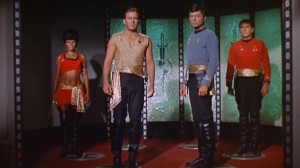 Well, not quite, but as reported in Universe Today (http://www.universetoday.com/99604/dont-tell-bones-are-we-one-step-closer-to-beaming-up/) it’s becoming more and more a reality. Recent major advances in the field of teleportation have been made opening up new and interesting pathways to other things as well:
Well, not quite, but as reported in Universe Today (http://www.universetoday.com/99604/dont-tell-bones-are-we-one-step-closer-to-beaming-up/) it’s becoming more and more a reality. Recent major advances in the field of teleportation have been made opening up new and interesting pathways to other things as well:
While we’re still a very long way off from instantly transporting from ship to planet à la Star Trek, scientists are still relentlessly working on the type of quantum technologies that could one day make this sci-fi staple a possibility. Just recently, researchers at the University of Cambridge in the UK have reported ways to simplify the instantaneous transmission of quantum information using less “entanglement,” thereby making the process more efficient — as well as less error-prone.
In a paper titled “Generalized teleportation and entanglement recycling” Cambridge researchers Sergii Strelchuk, Michal Horodecki and Jonathan Oppenheim investigate a couple of previously developed protocols for quantum teleportation.
So what? Now we have a bunch of guys hanging around trying to make Star Trek a reality – right? Guess again:
“Teleportation lies at the very heart of quantum information theory, being the pivotal primitive in a variety of tasks. Teleportation protocols are a way of sending an unknown quantum state from one party to another using a resource in the form of an entangled state shared between two parties, Alice and Bob, in advance. First, Alice performs a measurement on the state she wants to teleport and her part of the resource state, then she communicates the classical information to Bob. He applies the unitary operation conditioned on that information to obtain the teleported state.” (Strelchuk et al.)
It’s more than just ‘beaming around” the universe; the theoretical nature of teleportation also lies at the heart of creating a quantum computer – and this is very big business (as we already discussed in an earlier blog, “The CIA and Jeff Bezos: Working Together For (Our?) / The Future” in which the CIA is working with Amazon’s founder and Chief executive, Jeff Bezos, on the development of the world’s first quantum computer).
So understanding how transporters could theoretically work also impacts the development of the next generation of advanced computers – and with that, artificial intelligence, computer networks, the nature of how goods and products are processed and distributed, etc., etc., etc.
You get the idea; it’s not just about a bunch of geeks and nerds working on abstract notions: we’re talking about potentially big money and tremendous economic impact(s).
So where does all of this leave us now? Actually, pretty far along. Considering the sheer amount of information that makes up the also-difficult-to-determine state of a single object (in the case of a human, even simplistically speaking, about 10^28 kilobytes worth of data – or 100,000,000,000,000,000,000,000,000,000) – you’re obviously going to want to keep the amount of entanglement at a minimum. As the gentlemen from Cambridge point out:
Of course, we’re not saying we can teleport red-shirted security officers anywhere yet.
Still, with a more efficient method to reduce — and even recycle — entanglement, Strelchuk and his team are bringing us a little closer to making quantum computing a reality. And it may very well take the power of a quantum computer to even make the physical teleportation of large-scale objects possible… once the technology becomes available.
Remember: when we speak of transporters / teleportation, we’re really talking about the transmission of information. Teleportation is not just about magic and sci-fi stuff: it’s about hard data processing and transmission: get this down pat and we’re well on the way to bigger and better things:
“We are very excited to show that recycling works in theory, and hope that it will find future applications in areas such as quantum computation,” said Strelchuk. “Building a quantum computer is one of the great challenges of modern physics, and it is hoped that the new teleportation protocol will lead to advances in this area.”
Chances are, we may yet see a true quantum computer in our lifetime – and maybe, just maybe, we’ll also be able to ‘beam’ around objects, but not people anytime soon; the amount of information a person could be represented is likely to be staggering: it is estimated, on average, that an individual contains over 3 trillion base pairs of genes, and when one speaks of cells and the information contained by the billion of cells within us – and given that each of us are unique in our own way – don’t expect to see a working teleportation device anytime soon.
But a personal home teleportation device for objects? That may be coming sooner than you think. Just like fax machines sending written correspondence via electronic means we may have our own personal transporters, sending holiday or birthday gifts directly to our loved ones….






